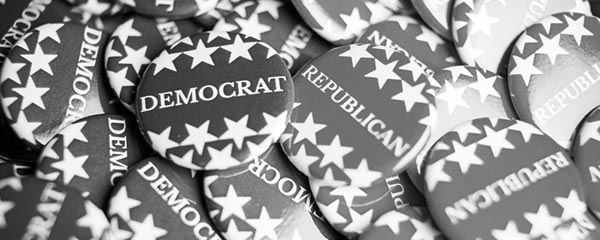Story Highlights
- 25% of registered voters say vote will be message of support for Trump
- 31% say vote will be message of opposition to Trump
- Midterm voters have been more likely to oppose president recently
WASHINGTON, D.C. -- A majority of U.S. registered voters, 56%, say they plan to use their vote in this year's midterm elections to send a message about President Donald Trump. That includes 25% who say their vote will be a sign of support for the president and 31% whose vote will express their opposition to him. Fewer voters in June, a combined 43%, planned to send a pro- or anti-Trump message with their vote this fall.
| June 2018 | September 2018 | Change | |||||||||||||||||||||||||||||||||||||||||||||||||||||||||||||||||||||||||||||||||||||||||||||||||
|---|---|---|---|---|---|---|---|---|---|---|---|---|---|---|---|---|---|---|---|---|---|---|---|---|---|---|---|---|---|---|---|---|---|---|---|---|---|---|---|---|---|---|---|---|---|---|---|---|---|---|---|---|---|---|---|---|---|---|---|---|---|---|---|---|---|---|---|---|---|---|---|---|---|---|---|---|---|---|---|---|---|---|---|---|---|---|---|---|---|---|---|---|---|---|---|---|---|---|---|
| % | % | pct. pts. | |||||||||||||||||||||||||||||||||||||||||||||||||||||||||||||||||||||||||||||||||||||||||||||||||
| Message to support Trump | 20 | 25 | +5 | ||||||||||||||||||||||||||||||||||||||||||||||||||||||||||||||||||||||||||||||||||||||||||||||||
| Message to oppose Trump | 23 | 31 | +8 | ||||||||||||||||||||||||||||||||||||||||||||||||||||||||||||||||||||||||||||||||||||||||||||||||
| Not sending a message | 53 | 41 | -12 | ||||||||||||||||||||||||||||||||||||||||||||||||||||||||||||||||||||||||||||||||||||||||||||||||
| Based on registered voters | |||||||||||||||||||||||||||||||||||||||||||||||||||||||||||||||||||||||||||||||||||||||||||||||||||
| Gallup | |||||||||||||||||||||||||||||||||||||||||||||||||||||||||||||||||||||||||||||||||||||||||||||||||||
The latest results are based on a Sept. 17-23 Gallup poll of 1,308 U.S. registered voters, conducted as the political world has been focused on the fate of Trump's Supreme Court nomination of Judge Brett Kavanaugh. Allegations of sexual misconduct by Kavanaugh when he was a teen were first made public on Sept. 14 and have since consumed the confirmation process. The same poll finds the American public reporting near-record enthusiasm about voting this fall, with Republicans and Democrats about equally enthused.
Roughly two-thirds of Democratic and Republican registered voters intend to send a message about Trump with their vote, with almost all Democrats who are doing so opposing Trump and almost all Republicans supporting him.
Fewer independent voters, 42%, plan to use their vote to comment on Trump, with more sending a message of opposition than of support (25% vs. 17%, respectively).
Since June, greater proportions of voters in all party groups view their vote as a message about Trump. The percentage of Republicans wanting to express support for Trump with their vote is up 12 percentage points, while there has been an 11-point increase in the percentage of Democrats using their vote to oppose him. Among independents, the percentage planning to use their vote to oppose Trump has gone up seven points, while the percentage wanting to send a message of support is up three points.
| June 2018 | September 2018 | Change | ||||||||||||||||||||||||||||||||||||||||||||||||||||||||||||||||||||||||||||||||||||||||||||||||||
|---|---|---|---|---|---|---|---|---|---|---|---|---|---|---|---|---|---|---|---|---|---|---|---|---|---|---|---|---|---|---|---|---|---|---|---|---|---|---|---|---|---|---|---|---|---|---|---|---|---|---|---|---|---|---|---|---|---|---|---|---|---|---|---|---|---|---|---|---|---|---|---|---|---|---|---|---|---|---|---|---|---|---|---|---|---|---|---|---|---|---|---|---|---|---|---|---|---|---|---|---|
| % | % | pct. pts. | ||||||||||||||||||||||||||||||||||||||||||||||||||||||||||||||||||||||||||||||||||||||||||||||||||
| Republicans | ||||||||||||||||||||||||||||||||||||||||||||||||||||||||||||||||||||||||||||||||||||||||||||||||||||
| Message to support Trump | 48 | 60 | +12 | |||||||||||||||||||||||||||||||||||||||||||||||||||||||||||||||||||||||||||||||||||||||||||||||||
| Message to oppose Trump | 4 | 6 | +2 | |||||||||||||||||||||||||||||||||||||||||||||||||||||||||||||||||||||||||||||||||||||||||||||||||
| Not sending a message | 47 | 32 | -15 | |||||||||||||||||||||||||||||||||||||||||||||||||||||||||||||||||||||||||||||||||||||||||||||||||
| Democrats | ||||||||||||||||||||||||||||||||||||||||||||||||||||||||||||||||||||||||||||||||||||||||||||||||||||
| Message to support Trump | 1 | 3 | +2 | |||||||||||||||||||||||||||||||||||||||||||||||||||||||||||||||||||||||||||||||||||||||||||||||||
| Message to oppose Trump | 50 | 61 | +11 | |||||||||||||||||||||||||||||||||||||||||||||||||||||||||||||||||||||||||||||||||||||||||||||||||
| Not sending a message | 47 | 35 | -12 | |||||||||||||||||||||||||||||||||||||||||||||||||||||||||||||||||||||||||||||||||||||||||||||||||
| Independents | ||||||||||||||||||||||||||||||||||||||||||||||||||||||||||||||||||||||||||||||||||||||||||||||||||||
| Message to support Trump | 14 | 17 | +3 | |||||||||||||||||||||||||||||||||||||||||||||||||||||||||||||||||||||||||||||||||||||||||||||||||
| Message to oppose Trump | 18 | 25 | +7 | |||||||||||||||||||||||||||||||||||||||||||||||||||||||||||||||||||||||||||||||||||||||||||||||||
| Not sending a message | 64 | 56 | -8 | |||||||||||||||||||||||||||||||||||||||||||||||||||||||||||||||||||||||||||||||||||||||||||||||||
| Based on registered voters | ||||||||||||||||||||||||||||||||||||||||||||||||||||||||||||||||||||||||||||||||||||||||||||||||||||
| Gallup | ||||||||||||||||||||||||||||||||||||||||||||||||||||||||||||||||||||||||||||||||||||||||||||||||||||
More Opposition Than Support for Presidents in Recent Midterms
Voters' use of their midterm vote to communicate their opposition to the sitting president is not unusual, historically. In the past three midterm election years -- 2006, 2010 and 2014 -- more voters in the final poll before the election said they intended to register their opposition to the president than to send their support for him. In 1998 and 2002, years in which the incumbent president was popular, more voters said they were supporting than opposing the president with their midterm vote.
The six-point deficit for Trump in midterm voting, with more sending a message against than for him, is smaller than the 13-point deficits George W. Bush and Barack Obama had in 2006 and 2014, respectively, but similar to the eight-point deficit for Obama in 2010.
| Message of support | Message of opposition | Not sending a message | |||||||||||||||||||||||||||||||||||||||||||||||||||||||||||||||||||||||||||||||||||||||||||||||||
|---|---|---|---|---|---|---|---|---|---|---|---|---|---|---|---|---|---|---|---|---|---|---|---|---|---|---|---|---|---|---|---|---|---|---|---|---|---|---|---|---|---|---|---|---|---|---|---|---|---|---|---|---|---|---|---|---|---|---|---|---|---|---|---|---|---|---|---|---|---|---|---|---|---|---|---|---|---|---|---|---|---|---|---|---|---|---|---|---|---|---|---|---|---|---|---|---|---|---|---|
| % | % | % | |||||||||||||||||||||||||||||||||||||||||||||||||||||||||||||||||||||||||||||||||||||||||||||||||
| Donald Trump (Sep 2018) | 25 | 31 | 41 | ||||||||||||||||||||||||||||||||||||||||||||||||||||||||||||||||||||||||||||||||||||||||||||||||
| Barack Obama (Oct-Nov 2014) | 17 | 30 | 51 | ||||||||||||||||||||||||||||||||||||||||||||||||||||||||||||||||||||||||||||||||||||||||||||||||
| Barack Obama (Oct 2010) | 22 | 30 | 44 | ||||||||||||||||||||||||||||||||||||||||||||||||||||||||||||||||||||||||||||||||||||||||||||||||
| George W. Bush (Nov 2006) | 18 | 31 | 46 | ||||||||||||||||||||||||||||||||||||||||||||||||||||||||||||||||||||||||||||||||||||||||||||||||
| George W. Bush (Oct-Nov 2002) | 28 | 15 | 53 | ||||||||||||||||||||||||||||||||||||||||||||||||||||||||||||||||||||||||||||||||||||||||||||||||
| Bill Clinton (Oct-Nov 1998) | 24 | 19 | 54 | ||||||||||||||||||||||||||||||||||||||||||||||||||||||||||||||||||||||||||||||||||||||||||||||||
| Based on registered voters | |||||||||||||||||||||||||||||||||||||||||||||||||||||||||||||||||||||||||||||||||||||||||||||||||||
| Gallup | |||||||||||||||||||||||||||||||||||||||||||||||||||||||||||||||||||||||||||||||||||||||||||||||||||
If the percentage of voters planning to send either a positive or negative message about Trump with their vote holds at 56% or increases between now and Election Day, it would be the highest to date, eclipsing the 52% for Obama in 2010.
It is unclear whether the percentage sending a message to Trump can be expected to increase between now and Election Day. Gallup asked the question on multiple occasions in 1998 and 2014. In 1998, between September and Election Day, more voters just before the midterms said they planned to send a message about Clinton, from 37% to 43%. But in 2014, the opposite occurred, with a decline in voters -- from 52% to 47% -- using their vote to express their pleasure or displeasure with Obama.
Implications
Midterm elections are often a referendum on the incumbent president's job performance, and with Trump's job approval at 40% and more voters saying their vote will be made to oppose rather than support the president, the Democratic Party stands to benefit. The key question to be answered on Election Day is likely how many seats the Democrats will gain -- and if it will be enough to win them the majority in the U.S. House and Senate -- rather than if they will gain. While registered voters, by 51% to 42%, currently say they will vote for the Democratic candidate rather than the Republican candidate in their district, turnout will be a major determining factor in the eventual outcome. Currently, neither party appears to have an advantage in terms of their supporters' stated certainty of voting or their enthusiasm for doing so.
Explore President Trump's approval ratings and compare them with those of past presidents in the Gallup Presidential Job Approval Center.
View complete question responses and trends.
Learn more about how the Gallup U.S. Poll works.




